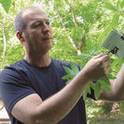Associations between higher plants and their gall-forming arthropod parasites are among the most specific, intimate and tightly co-evolved interspecific interactions known in macroscopic organisms. Galling insects, by definition, do not merely feed upon their host plants, but induce their hosts to form a bewildering array of highly specific tumor-like structures via biochemical interactions with plant hormones and regulatory mechanisms of gene expression (Fig. 1; Price et al., 1987). Recent research has demonstrated that in addition to inducing gross morphological changes, these gall-forming parasites often employ a diversity of more subtle manipulations of plant physiology and chemistry. These include the induction of sugary secretions (Fernandes et al., 1999), increased concentrations of defensive compounds in external gall tissues (e.g. Hartley, 1998), decreased concentrations of defensive chemicals and increased concentrations of nutrients (e.g. amino acids and lipids) in gall-nutritive tissues (Koyama et al., 2004), and suppression of the release of volatile organic compounds (VOCs) (Tooker & De Moraes, 2007).
Available at: http://works.bepress.com/don-cipollini/106/
